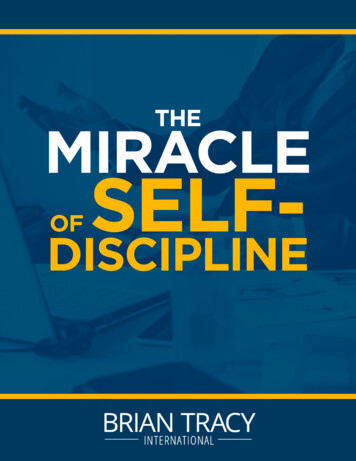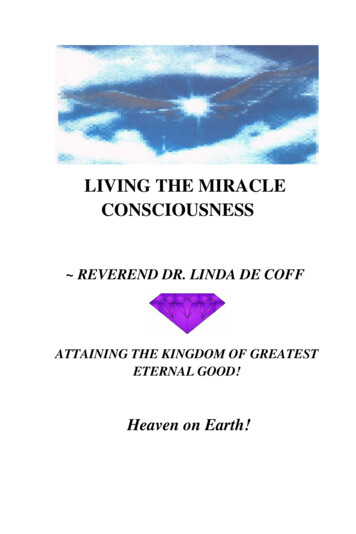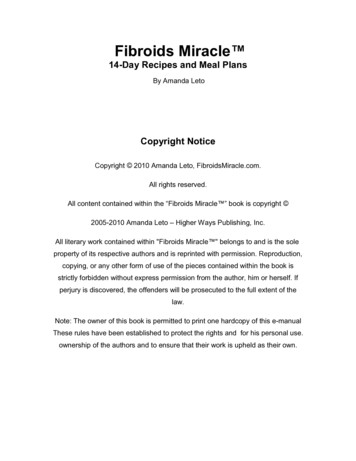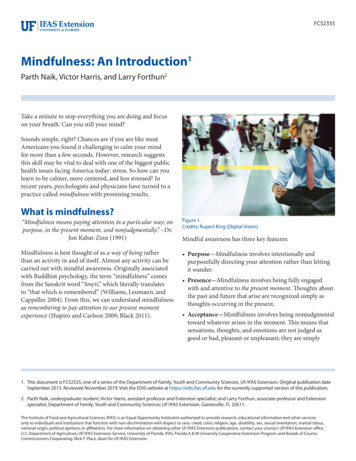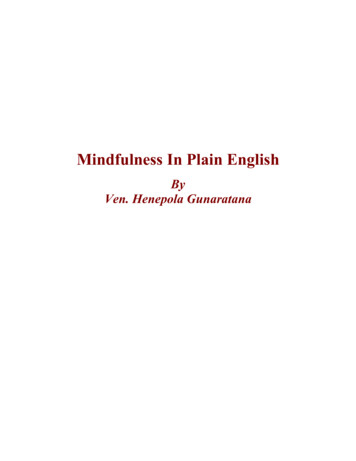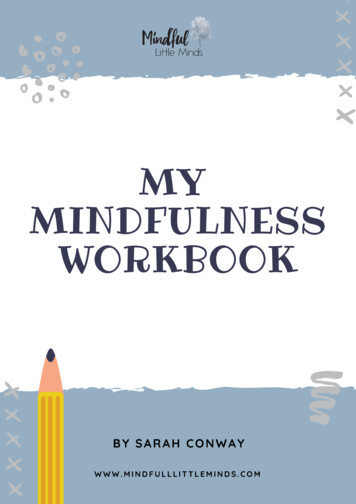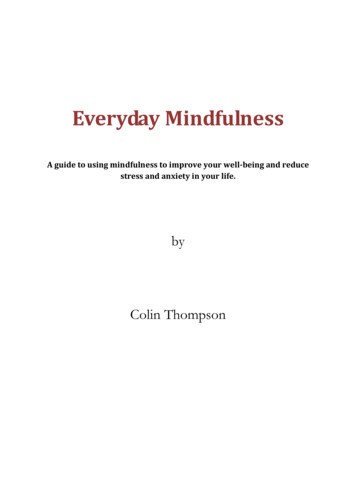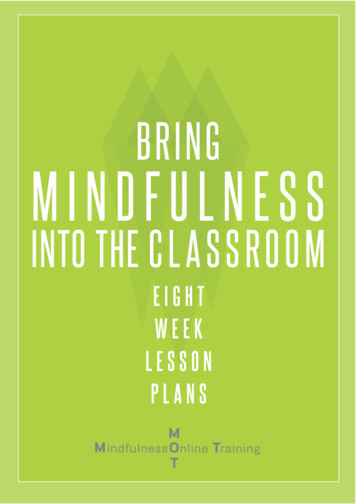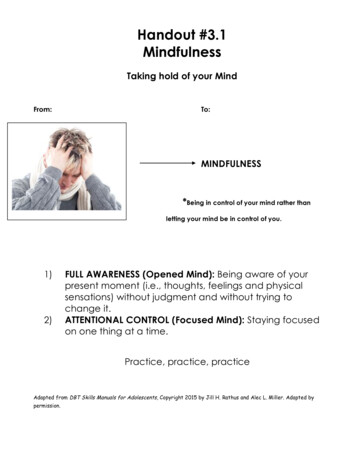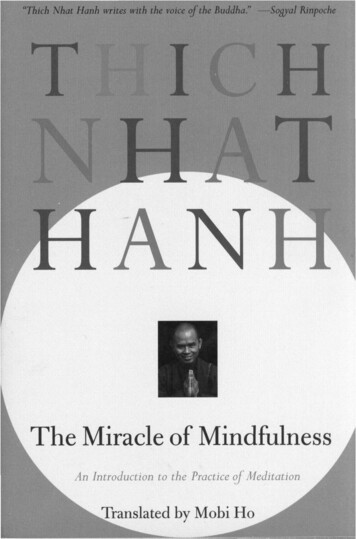
Transcription
The Miracle of MindfulnessAn Introduction to the Practiceif MeditationTranslated by Mobi Ho
Thich Nhat Hanh Translated by Mobi Ho With Eleven Drawings by Vo-Dinh Mai
The Miracleof MindfulnessAn Introduction to the Practiceof Meditation Beacon PressBoston
Beacon Press25 Beacon StreetBoston, Massachusetts 02108-2892www.beacon.orgBeacon Press booksare published under the auspices ofthe Unitarian Universalist Association of Congregations. 1975, 1976 by Thich Nhat HanhPreface and English translation 1975, 1976, 1987byMobiHoAfterword 1976 by James ForestArtwork 1987 by Vo-Dinh MaiAll rights reservedPrinted in the United States of America09 08 07 06 05 11 10 9 8 7The Library of Congress catalogued the previouspaperback edition as follows:Nhiit Hanh, Thich.The miracle of mindfulness.Translation of Phep la cua su tinh thuc.ISBN 0-8070-1232-7 (cloth)ISBN 0-8070-1239-4 (paper)1. Meditation (Buddhism) 2. Buddhist meditations.I. Title.BQ5618.V5N4813 1987294.3'433 87-42582
ContentsTranslator's Preface by Mobi HoOneThe Essential Disciplinevii1TwoThe Miracle Is to Walk on EarthThreeA Day of Mindfulness1127FourThe Pebble33FiveOne Is All, All Is One: The Five AggregatesSixThe Almond Tree in Your Front YardSevenThree Wondrous Answersv695545
Exercises in Mindfulness79Nhat Hanh: Seeing with the Eyes of Compassionby James Forest101Selection of Buddhist Sutrasvi109
Translator's PrefaceThe Miracle of Mindfulness was originally written inVietnamese as a long letter to Brother Quang, amain staff member of the School of Youth for Social Service in South Vietnam in 1974. Its author,the Buddhist monk Thich Nhat Hanh, hadfounded the School in the 1960s as an outgrowthof "engaged Buddhism." It drew young peopledeeply committed to acting in a spirit of compassion. Upon graduation, the students used thetraining they received to respond to the needs ofpeasants caught in the turmoil of the war. Theyhelped rebuild bombed villages, teach children,set up medical stations, and organize agriculturalcoopera tives.The workers' methods of reconciliation wereoften misunderstood in the atmosphere of fearand mistrust engendered by the war. They persistently refused to support either armed partyvii
and believed that both sides were but the reflection of one reality, and the true enemies were notpeople, but ideology, hatred, and ignorance.Their stance threatened those engaged in the conflict, and in the first years of the School, a seriesof attacks were carried out against the students.Several were kidnapped and murdered. As thewar dragged on, even after the Paris Peace Accords were signed in 1973, it seemed at times impossible not to succumb to exhaustion andbitterness. Continuing to work in a spirit of loveand understanding required great courage.From exile in France, Thich Nhat Hanh wroteto Brother Quang to encourage the workers during this dark time. Thay Nhat Hanh ("Thay," theform of address for Vietnamese monks, means"teacher") wished to remind them of the essentialdiscipline of following one's breath to nourish andmaintain calm mindfulness, even in the midst ofthe most difficult circumstances. Because BrotherQuang and the students were his colleagues andfriends, the spirit of this long letter that becameThe Miracle of Mindfulness is personal and direct.When Thay speaks here of village paths, hespeaks of paths he had actually walked withBrother Quang. When he mentions the bright eyesof a young child, he mentions the name of BrotherQuang's own son.I was living as an American volunteer withthe Vietnamese Buddhist Peace Delegation inParis when Thay was writing the letter. Thayheaded the delegation, which served as an overviii
seas liaison office for the peace and reconstructionefforts of the Vietnamese Buddhists, including theSchool of Youth for Social Service. I remember lateevenings over tea, when Thay explained sectionsof the letter to delegation members and a few closefriends. Quite naturally, we began to think ofother people in other countries who might alsobenefit from the practices described in the book.Thay had recently become acquainted withyoung Buddhists in Thailand who had been inspired by the witness of engaged Buddhism inVietnam. They too wished to act in a spirit ofawareness and reconciliation to help avert thearmed conflict erupting in Thailand, and theywanted to know how to work without being overcome by anger and discouragement. Several ofthem spoke English, and we discussed translatingBrother Quang's letter. The idea of a translationtook on a special poignancy when the confiscationof Buddhist publishing houses in Vietnam madethe project of printing the letter as a small bookin Vietnam impossible.I happily accepted the task of translating thebook into English. For nearly three years, I hadbeen living with the Vietnamese Buddhist PeaceDelegation, where day and night I was immersedin the lyrical sound of the Vietnamese language.ThaY'had been my "formal" Vietnamese teacher;we had slowly read through some of his earlierbooks, sentence by sentence. I had thus acquireda rather unusual vocabulary of VietnameseBuddhist terms. Thay, of course, had been teachix
ing me far more than language during those threeyears. His presence was a constant gentle reminder to return to one's true self, to be awakeby being mindful.As I sat down to translate The Miracle of Mindfulness, I remembered the episodes during the pastyears that had nurtured my own practice of mindfulness. There was the time I was cooking furiously and could not find a spoon I'd set downamid a scattered pile of pans and ingredients. AsI searched here and there, Thay entered thekitchen and smiled. He asked, "What is Mobilooking for?" Of course, I answered, "The spoon!I'm looking for a spoon!" Thay answered, againwith a smile, "No, Mobiis looking for Mobi."Thay suggested I do the translation slowlyand steadily, in order to maintain mindfulness. Itranslated only two pages a day. In the evenings,Thay and I went over those pages, changing andcorrecting words and sentences. Other friendsprovided editorial assistance. It is difficult to describe the actual experience of translating hiswords, but my awareness of the feel of pen andpaper, awareness of the position of my body andof my breath enabled me to see most clearly themindfulness with which Thay had written eachword. As I watched my breath, I could see BrotherQuang and the workers of the School of Youthfor Social Service. More than that, I began to seethat the words held the same personal and livelydirectness for any reader because they had beenx
written in mindfulness and lovingly directed toreal people. As I continued to translate, I couldsee an expanding community-the School's workers, the young Thai Buddhists, and many otherfriends throughout the world.When the translation was completed wetyped it, and Thay printed a hundred copies onthe tiny offset machine squeezed into the delegation's bathroom. Mindfully addressing eachcopy to friends in many countries was a happytask for delegation members.Since then, like ripples in a pond, The Miracleof Mindfulness has traveled far. It has been translated into several other languages and has beenprinted or distributed on every continent in theworld. One of the joys of being the translator hasbeen to hear from many people who have discovered the book. I once met someone in a bookstorewho knew a student who had taken a copy tofriends in the Soviet Union. And recently, I meta young Iraqi student in danger of being deportedto his homeland, where he faces death for hisrefusal to fight in a war he believes cruel andsenseless; he and his mother have both read TheMiracle of Mindfulness and are practicing awarenessof the breath. I have learned, too, that proceedsfrom the Portuguese edition are being used to assist poor children in Brazil. Prisoners, refugees,health-care workers, educators, and artists areamong those whose lives have been touched bythis little book. I often think of The Miracle of Mind-xi
fulness as something of a miracle itself, a vehiclethat continues to connect lives throughout theworld.American Buddhists have been impressed bythe natural and unique blending of Theravada andMahayana traditions, characteristic of VietnameseBuddhism, which the book expresses. As a bookon the Buddhist path, The Miracle of Mindfulnessis special because its clear and simple emphasison basic practice enables any reader to begin apractice of his or her own immediately. Interestin the book, however, is not limited to Buddhists.It has found a home with people of many differentreligious traditions. One's breath, after all, ishardly attached to any particular creed.Those who enjoy this book will likely be interested in other books by Thich Nhat Hanh whichhave been translated into English. His books inVietnamese, including short stories, novels, essays, historical treatises on Buddhism and poetry,number in the dozens. While several of his earlierbooks in English are no longer in print, more recent works available in translation include A Guideto Walking Meditation, Being Peace, and The Sun MyHeart.Denied permission to return to Vietnam,Thich Nhat Hanh spends most of the year livingin Plum Village, a community he helped found inFrance. There, under the guidance of the sameBrother Quang to whom The Miracle of Mindfulnesswas originally addressed years ago, communitymembers tend hundreds of plum trees. Profitsxii
from the sales of their fruit are used to assist hungry children in Vietnam. In addition, Plum Villageis open every summer to visitors from around theworld who wish to spend a month of mindfulnessand meditation. In recent years, Thich Nhat Hanhhas also made annual visits to the United Statesand Canada to conduct week-long retreats organized by the Buddhist Peace Fellowship.I would like to express special gratitude toBeacon Press for having the vision to print thisnew edition of The Miracle of Mindfulness. I hopethat each new person whom it reaches will sensethat the book is addressed as personally to himor her as it was to Brother Quang and the workersof the School of Youth for Social Service.Mobi HoAugust 1987xiii
The Miracle ofMindfulness
One The Essential Discipline,Yesterday Allen came over to visitwith his son Joey. Joey has grown soquickly! He's already seven years oldand is fluent in French and English. He even usesa bit of slang he's picked up on the street. Raisingchildren here is very different from the way weraise children at home. Here parents believe that"freedom is necessary for a child's development."During the two hours that Allen and I weretalking, Allen had to keep a constant eye on Joey.Joey played, chattered away, and interruptedus, making it impossible to carryon a real conversation. I gave him several picture books forchildren but he barely glanced at them beforetossing them aside and interrupting our conversation again. He demands the constant attention of grown-ups.Later, Joey put on his jacket and went outside to play with a neighbor's child. I askedAllen, "Do you find family life easy?" Allen1
didn't answer directly. He said that during thepast few weeks, since the birth of Ana, he hadbeen unable to sleep any length of time. Duringthe night, Sue wakes him up and-because sheis too tired herself-asks him to check to makesure Ana is still breathing. "I get up and lookat the baby and then come back and fall asleepagain. Sometimes the ritual happens two orthree times a night.""ls family life easier than being a bachelor?" I asked. Allen didn't answer directly. ButI understood. I asked another question: "A lotof people say that if you have a family you'reless lonely and have more security. Is thattrue?" Allen nodded his head and mumbledsomething softly. But I understood.Then Allen said, "l've discovered a way tohave a lot more time. In the past, I used to lookat my time as if it were divided into severalparts. One part I reserved for Joey, another partwas for Sue, another part to help with Ana, another part for household work. The time leftover I considered my own. I could read, write,do research, go for walks."But now I try not to divide time into partsanymore. I consider my time with Joey and Sueas my own time. When I help Joey with his homework, I try to find ways of seeing his time as myown time. I go through his lesson with him,sharing his presence and finding ways to beinterested in what we do during that time. Thetime for him becomes my own time. The samewith Sue. The remarkable thing is that now Ihave unlimited time for myself!"2
Allen smiled as he spoke. I was surprised.I knew that Allen hadn't learned this from reading any books. This was something he haddiscovered for himself in his own daily life.Washing the dishes to wash the dishesThirty years ago, when I was still a noviceat Tu Hieu Pagoda, washing the dishes washardly a pleasant task. During the Season ofRetreat when all the monks returned to themonastery, two novices had to do all the cookingand wash the dishes for sometimes well overone hundred monks. There was no soap. We hadonly ashes, rice husks, and coconut husks, andthat was all. Cleaning such a high stack of bowlswas a chore, especially during the winter whenthe water was freezing cold. Then you had toheat up a big pot of water before you could doany scrubbing. Nowadays one stands in a kitchenequipped with liquid soap, special scrubpads,and even running hot water which makes it allthe more agreeable. It is easier to enjoy washingthe dishes now. Anyone can wash them in ahurry, then sit down and enjoy a cup of teaafterwards. I can see a machine for washingclothes, although I wash my own things out byhand, but a dishwashing machine is going justa little too far!While washing the dishes one should onlybe washing the dishes, which means that whilewashing the dishes one should be completelyaware of the fact that one is washing the dishes.At first glance, that might seem a little silly:3
why put so mu
The Miracle of Mindfulness was originally written in Vietnamese as a long letter to Brother Quang, a main staff member of the School of Youth for So cial Service in South Vietnam in 1974. Its author, the Buddhist monk Thich Nhat Hanh, had founded the School in the 1960s as an outgrowth of "engaged Buddhism." It drew young people deeply committed to acting in a spirit of compas sion. Upon .
